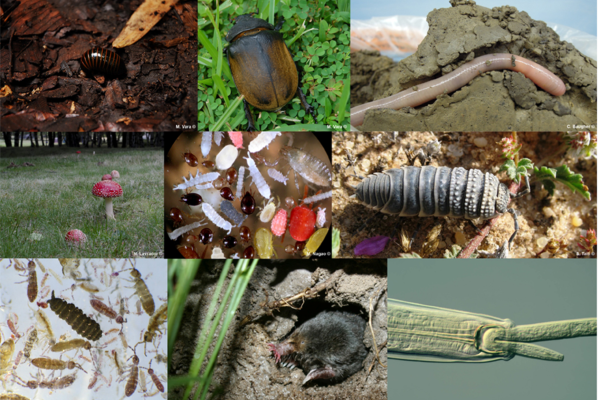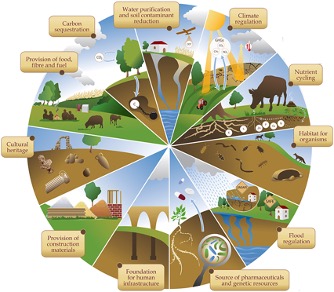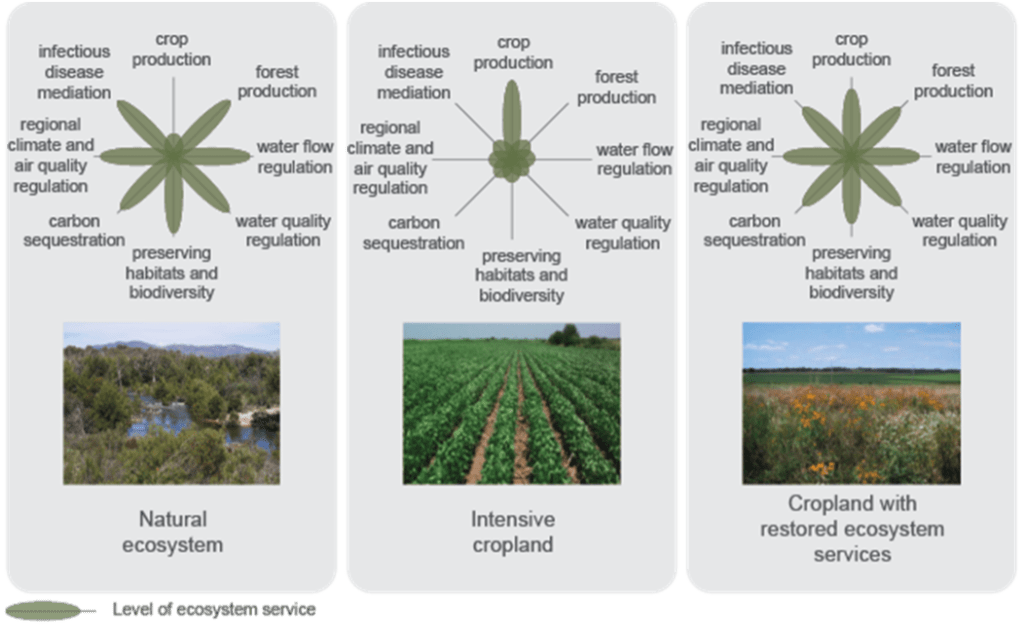Dr Anna Hopkins from Edith Cowan University in Western Australia gave an invited presentation for TERN’s webinar about agricultural ecosystems on 4 May 2022. She discussed the abundant life found in soils and how this is important for agriculture.
Soil, or rather the living things in it, provides key ecosystem services including carbon-sequestration and climate regulation. Dr Hopkins said that by sustainably maintaining and improving conditions for soil life through appropriate management, agricultural soils can better deliver such services while also becoming more fertile and productive.
More than just dirt
Dr Hopkins compared soils to freshwater ecosystems. She said that most people understand rivers and lakes to include more than just water. Freshwater ecosystems usually feature abundant life, most obviously fish and invertebrates, but also plants. Submerged rocks and logs provide many important habitats. Dr Hopkins said that whereas many people may think of soils as just dirt, soil ecosystems are actually quite comparable to aquatic ecosystems. The main differences are that soils are difficult to see into, and that soil biota is mostly tiny. For these reasons, people seldom appreciate soils’ true biological diversity. In fact, one quarter of the total biodiversity on Earth is soil life. Most is microscopic, including bacteria, fungi, and myriad other microbes. Yet soils are also often home to larger invertebrates and digging vertebrates. Soils are a lot richer and more complicated than most people think.
One reason for the diversity is that soils contain many microhabitats, each supporting different kinds of life. Habitats include surface-level plant litter, micropores, and relatively large voids called macropores. Furthermore, microfilms of water coat soil objects, and in these films live water organisms including tardigrades. Soils also contain many kinds of plant, large and small, each with very different roots that provide habitats associated with particular sets of organisms. Each tree species, for example, has its own set of intimate root fungi species. Generally, the more diverse the biota is above ground, the more diverse it will below ground too.

Soil's ecological services
Soils, like most ecosystems, provide certain services or processes, one of the most important being nutrient cycling. For that, the soil biota, especially fungi and bacteria, is vitally important. Therefore, caring for this biota maintains or improves nutrient cycling.
Specifically, decomposer organisms break down organic matter and make its constituent nutrients available to other organisms such as plants. Without decomposers, nutrients would not be available and the soil would be barren.
Another example of nutrient cycling is nitrogen-fixing bacteria, which are critical to soil fertility. Plants, and all living things, need nitrogen; it is a key component of proteins and DNA. Although the Earth’s atmosphere is 78 per cent nitrogen, plants cannot access it directly. Instead, they get nitrogen indirectly via soil bacteria. The bacteria take nitrogen from the air and combine it with hydrogen to get ammonia (NH4) or oxygen to get nitrate (NO3–). Both ammonia and nitrate are ingredients in fertilisers because plants can absorb these substances and obtain nitrogen from them.
Certain plants, especially the Fabaceae (legume) family, provide enlarged root nodules to encourage the bacteria. Nitrogen gets into the ecosystem and starts to circulate via animals eating the plants. Animal excretions, rich in ammonia and other nitrogen compounds, are deposited into the soil directly; also, when animals die, bacteria liberate the nitrogen compounds from their tissues. So eventually nitrogen compounds available to plants enrich the soil. And since plants need these to grow, nitrogen content is an indicator of soil fertility. Other soil bacteria reverse the process, turning soil nitrogen back into atmospheric nitrogen, completing the nitrogen cycle.

Dr Hopkins mentioned the Australian Microbiome project. Researchers from CSIRO and affiliate organisations collect water and soil samples from many sites, representing many different ecosystems. Samples are tested using molecular tools to identify traces of environmental DNA. Doing this allows a multitude of small organisms to be identified very quickly and conveniently, giving an accurate assessment of diversity. The Microbiome team determined which bacteria and fungi exist in the soils of the sampled ecosystems. This distribution can be compared against ecosystem function, giving an indication of how agricultural practices affect soil biodiversity.
Dr Hopkins used an example from her own work to illustrate such effects. She compared pasture soils with those of remnant vegetation patches. The biomes of each were totally different, showing that changing land use or agricultural practices changes the soil biota, and not necessarily for the better.
This adds to what was already known about conventional agriculture degrading soil. Agriculture reduces organic matter, lowering soil water-holding capacity and fertility. Monoculture crops are also typically shallow-rooted, and not present in the soil continuously. So, the soil is sometimes bare, vulnerable to wind and water erosion, causing still-further nutrient losses. Farmers usually have to add artificial fertilisers to replace what was lost. Other things usually added to soils are pesticides and herbicides, which severely impact biodiversity. Conventional agriculture also degrades soil structure, causing compaction, leading to poor drainage and waterlogging; these effects reduce habitat diversity and soil biodiversity. Overall, modern farming has a negative effect on soils.

A growing movement
Dr Hopkins described a growing awareness of the importance of soil bacteria, not just for recycling nutrients, but also as a major source of soil carbon. For many years soil scientists assumed that soil carbon comes mostly from broken down leaf litter. However, the Australian Microbiome survey revealed that much of the carbon is actually decomposed soil microbes, especially bacteria. Knowing this underscores the importance of management practices that cultivate bacteria. More bacteria mean more soil carbon, which translates to better retention of water and nutrients, and improved soil structure. All of this represents improved soil ecosystem services.
The new awareness has become a global movement aimed at combatting the problems conventional agriculture causes. This movement is called organic or regenerative agriculture; it sustains and improves soil rather than degrading it. Some of the principles of regenerative agriculture include zero soil tillage, maintaining ground cover throughout the year, short-rotation grazing, and maintaining an abundance of living roots in the soil. These principles were learned from natural ecosystems and are now being used to improve agricultural soil health.
Dr Hopkins said that although interest in this style of agriculture is high, it is also a fairly new field of study. So far, little information exists about how well regenerative agriculture is working, or about which methods work best. Dr Hopkins is collaborating with farmers of the Western Australian wheat belt to find answers. She will be studying the amounts of organic matter in soils to determine the effects of different regenerative methods on soil microbes and carbon sequestration. This should be a fruitful area of investigation.
A related question will be whether organic agriculture produces healthier food, given that conventional agriculture typically yields poor-quality food. Sustainable agriculture may therefore have a bonus effect on human nutrition and health.
Agriculture is changing globally, Dr Hopkins concluded. Emerging practices support and encourage soil biota, fostering natural soil ecosystem processes, including carbon sequestration and nutrient cycling. This promotes soil recovery and sustainable farming.







